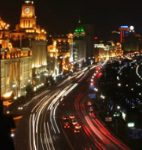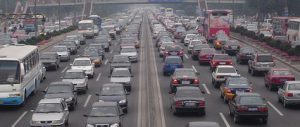Transportation is responsible for nearly a quarter of all greenhouse-gas emissions worldwide. But compared with the electricity sector, little effort has been put into mitigation. Worse still, transport emissions are growing at a faster pace than emissions in any other sector. Emblematic of this calamitous development has been the motorisation of Chinese mobility. Thirty years ago, Beijing had fewer than 100,000 motor vehicles on the road; now there are more than 3.6 million.
Accumulated responsibility for emissions lies to a greater extent with industrialised OECD countries than with China, and no one wants to deny Chinese citizens the dream of private mobility. Yet there are good reasons for China to act against climate change. The consequences of climate change pose a serious threat; consider, for example, that China’s water supply is crucially dependent upon rapidly shrinking glaciers in the Himalayas. The problems also extend beyond climate change: rapid economic development and motorisation pose other imminent hazards to citizens.
The roads of the Chinese capital carry one-tenth of the country’s cars, but the city is home to only one-hundredth of its population. As a result, Beijing’s arteries are clogged well beyond the morning and evening rush hours. Cars delay not only other cars but also overcrowded buses; it takes hours for commuters to arrive at work. Air pollution causes asthma and lung cancer. More than 1,000 people are killed every year after being hit by cars, further discouraging cycling – the most environmentally sustainable transit mode in Chinese cities, and until recently the most popular one. Pedestrians and cyclists are now encircled by broad arteries, physical barriers that impede their mobility. In short, Beijing is living a transport nightmare.
Many Chinese aspire to car ownership, and mobility is a desirable goal. But how do the economic benefits trade off against the disadvantages? This question can be answered by attempting to monetise congestion and other hazards. Using established methodologies, Dongquan He from the Energy Foundation China and I estimated the time lost in congestion, health costs due to air pollution, stress costs of traffic noise and even the value of lives lost by accidents. Climate-change damage costs can be evaluated by the total carbon dioxide emissions produced by vehicles driven in Beijing.
The damage costs are dramatic. Even using a very conservative estimate, congestion and air pollution each account for around 20 billion yuan (US$2.9 billion) each year. The time lost for bus passengers caught in congestion adds another 6 billion yuan (US$877 million), even though bus patrons usually value time less than do car drivers. Accidents and noise pollution are relatively small costs, each around 1 billion yuan (US$146 million). Surprisingly, climate-change damage costs are dwarfed by congestion and air pollution costs for Beijing citizens, and amount to 1.4 billion yuan (US$205 million). Altogether these values, computed for the year 2005, constitute 7.5% of GDP in Beijing. Since 2005, the situation has only deteriorated, with more than a million cars added to the streets of the capital.
However, climate change is certainly not irrelevant when we consider Beijing’s traffic nightmare. Uncertainty about the value of social costs is much higher for climate change than for the other environmental hazards. In the high estimate of motorisation’s social costs (15% of Beijing’s GDP), climate-change costs are as high as those of air pollution and congestion.
So how can Beijing tackle the crisis? As Alex Pasternack has written on chinadialogue, smart growth is the way forward: new satellite towns have to be planned around public transit; land use, work and living need to be reorganised around travelling shorter distances. However, the existing infrastructure of broad arteries, superblocks and commuter towns far away from Beijing’s Central Business District can not simply be undone.
Beijing successfully limited car transportation around the Olympic Games with periodic driving bans, which were extended in a milder version beyond the Games. However, such measures do not help in the long run: new cars fill up the road and car drivers even buy second vehicles to circumvent the driving ban. Air pollution is also improved, in relative terms, by prohibiting the use of older, more polluting vehicles. However, here symptoms are treated while the underlying situation degrades due to increasing motorisation.
To get at the underlying problem in this case, economic theory calls for cost internalisation measures. Traditionally, this means congestion charging. However, I prefer “city toll” as both a name and a concept, since the goal is not only to tackle congestion, but also to mitigate the worst impact of environmental damage and address other concerns. The central idea is that polluters pay a fee that matches mobility demand with the social costs of car transportation.
In Beijing, a city toll would reduce car traffic by one quarter, providing major congestion relief, increasing average speed from 21 to 28 kilometres per hour and reducing air pollution and climate-change impact. Car drivers benefit the most from congestion relief as speed and reliability is increased dramatically. But it is also car drivers who must pay the fee. To realise the benefits, a daily city toll would need to equal or exceed 50 yuan (US$7.30), a considerable amount for most car drivers and hence seen as unattractive to policymakers in the Beijing municipality.
It helps to delve a little deeper into economic theory. “Demand elasticity” describes how people react to price signals. For a city toll, it is beneficial when people are relatively sensitive to price signals and reduce driving accordingly. Higher demand elasticity means that a lower city toll — one that costs car drivers less — can achieve higher benefits, a very attractive outcome. The next question is: how can demand elasticity be increased?
The most decisive measure is probably the speed and availability of buses and subways. When these modes of transportation are conveniently available, car drivers can switch easily to public transit. In fact, the ready availability of public transit may reduce the “optimal” city toll by 10 yuan (US$1.50) a day while even further reducing car transportation and its harmful impact.
City planners in the capital understand that Beijing needs more than ring roads and broad arteries, and significant investment is going into an impressive subway network. According to the construction schedule, the subway system will be extended from the current 200 kilometres, to more than 560 kilometres by 2015. This extension will help to avoid pushing additional commuters into cars. But it is insufficient to tackle the current traffic gridlock. To this end, bus rapid transit should be designed with high capacity and implemented at comparatively small costs, re-assigning the road for more efficient mobility. Exclusive lanes for bicycles and electronic bicycles could counter the downward trend in popularity of this individualised but environmentally friendly mode of transport. A city toll, bus rapid transit, subways and an infrastructure friendly to pedestrians and cyclists could together provide a formidable way forward to a sustainable and energy resilient city.
The surprising insight is that mitigating climate change through transport demand management is highly beneficial for car drivers, who can enjoy relatively free roads – and for citizens who will love more “blue sky days”. Of course, political courage is required to take the automobile lobby out of the proverbial driver’s seat, and discourage, if not ownership, at least car usage.
Felix Creutzig is postdoctoral fellow at the Berkeley Institute of the Environment, UC Berkeley and has worked for the Energy Foundation China in Beijing. The complete study was recently published in Transportation Research D.
Homepage photo by Shazari



